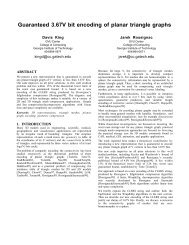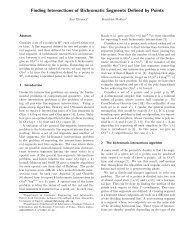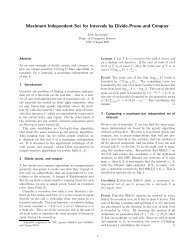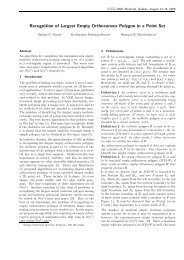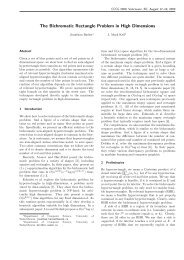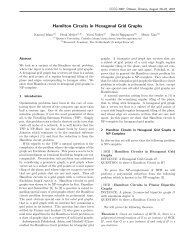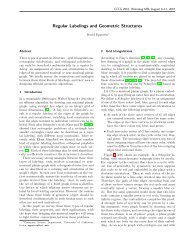Inner diagonals of convex polytopes P
Inner diagonals of convex polytopes P
Inner diagonals of convex polytopes P
You also want an ePaper? Increase the reach of your titles
YUMPU automatically turns print PDFs into web optimized ePapers that Google loves.
<strong>Inner</strong> <strong>diagonals</strong> <strong>of</strong> <strong>convex</strong> <strong>polytopes</strong><br />
Extended Abstract<br />
DavidBremnerandVictorKlee ∗<br />
1 Introduction<br />
An inner diagonal <strong>of</strong> a polytope P is a segment that joins<br />
two vertices <strong>of</strong> P and that lies, except for its ends, in P ’s<br />
relative interior. For 1 ≤ i ≤ d, ani-diagonal <strong>of</strong> a d-polytope<br />
P is a segment [x, y] whose ends are vertices <strong>of</strong> P and whose<br />
carrier in P (i.e., the smallest face <strong>of</strong> P that contains [x, y])<br />
is <strong>of</strong> dimension i. Thenumber<strong>of</strong>P’s i-<strong>diagonals</strong> is denoted<br />
by δ i(P ). Thus δ 1(P )isthenumber<strong>of</strong>P’s edges and δ d (P )<br />
is the number <strong>of</strong> P ’s inner <strong>diagonals</strong>. Thefocushereisonδ d .<br />
It seems strange that, except for d = 2, so little attention<br />
has been paid to inner <strong>diagonals</strong> <strong>of</strong> d-<strong>polytopes</strong>. There<br />
is an interesting paper <strong>of</strong> Mani [10] and an attractive open<br />
problem <strong>of</strong> von Stengel [13] (see Section 4), but we know<br />
<strong>of</strong> little else. Following some preliminaries in Section 2, our<br />
main results appear in Section 3. They consist <strong>of</strong> the determination,<br />
for each f ≥ 4, <strong>of</strong> both the minimum and the<br />
maximum <strong>of</strong> δ 3(P )asP ranges over all simple 3-<strong>polytopes</strong><br />
that have precisely f facets. Section 4 contains some results<br />
on inner <strong>diagonals</strong> <strong>of</strong> higher-dimensional <strong>polytopes</strong>, including<br />
the determination for all d <strong>of</strong> the maximum number <strong>of</strong><br />
inner <strong>diagonals</strong> <strong>of</strong> d-<strong>polytopes</strong> having a given number <strong>of</strong> vertices.<br />
2 Preliminaries<br />
We use v(P )andf(P) to denote respectively the number<br />
<strong>of</strong> vertices and the number <strong>of</strong> facets ((d − 1)-faces) <strong>of</strong> a d-<br />
polytope P. Ad-polytope is simplicial if each <strong>of</strong> its facets is<br />
a simplex, and it is simple ifeach<strong>of</strong>itsverticesisincident<br />
to precisely d edges (equivalently, to precisely d facets).<br />
We say that two vertices <strong>of</strong> a polytope are estranged if<br />
they do do not lie together on any facet, and that two facets<br />
are estranged if they do not share any vertex. Note that<br />
two vertices are joined by an inner diagonal if and only if<br />
they are estranged. Note also that under the standard polarity<br />
operation for <strong>polytopes</strong>, simple <strong>polytopes</strong> correspond<br />
to simplicial <strong>polytopes</strong>, the vertices <strong>of</strong> a polytope correspond<br />
to the facets <strong>of</strong> its polar, and estranged pairs <strong>of</strong> vertices in<br />
a polytope correspond to estranged pairs <strong>of</strong> facets in its polar.<br />
We use the notation DMAX V d (n) (resp.EMAX V d (n)) to<br />
denote the class <strong>of</strong> d-<strong>polytopes</strong> that maximize, among the<br />
d-<strong>polytopes</strong> with n vertices, the number <strong>of</strong> inner <strong>diagonals</strong><br />
(resp. estranged pairs <strong>of</strong> facets). The notations DMAX F d (n)<br />
and EMAX F d (n) are defined similarly with respect to fixing<br />
∗ Both authors are with the Dept. <strong>of</strong> Mathematics, University <strong>of</strong><br />
Washington. email: bremner@math.washington.edu. Research <strong>of</strong> the<br />
first author was supported by NSERC Canada. Research <strong>of</strong> the second<br />
author was supported in part by NSF U.S.A. A full version <strong>of</strong> this<br />
paper has been accepted for publication in J. Comb. Theory A.<br />
the number <strong>of</strong> facets. The following two remarks are immediate<br />
consequences <strong>of</strong> the basic definitions.<br />
2.1. Remark. For each , P d-polytope P ,<br />
i δi(P )=, <br />
v(P)<br />
2 ,<br />
v(P)<br />
with δ 1(P )+δ d (P)=<br />
2 when P is simplicial.<br />
2.2. Remark. If a d-polytope P has at least one inner diagonal,<br />
then v(P ) ≥ d +2 and f(P ) ≥ 2d.<br />
A d-polytope P is called a pyramid if there is a facet F<br />
<strong>of</strong> P that contains all but one vertex <strong>of</strong> P . Each facet that<br />
hasthispropertyiscalledabase <strong>of</strong> the pyramid and the<br />
remaining vertex is called an apex. Note that for each choice<br />
<strong>of</strong> d ≥ 3, v>d,andf>d,thereisad-pyramid that has<br />
v vertices and there is a d-pyramid that has f facets. Note<br />
also that when d ≥ 2ad-pyramid has no estranged pair <strong>of</strong><br />
facets and also no estranged pair <strong>of</strong> vertices.<br />
When Q is an (f − 1)-facet (d − 1)-polytope in R d−1 and<br />
F is a facet <strong>of</strong> Q, awedge over Q with foot F is an f-facet<br />
d-polytope W obtained from the product Q × [0, 1] by (in<br />
effect) collapsing F ×[0, 1] to F ×{0}. We use the following<br />
easily verified property <strong>of</strong> wedges.<br />
2.3. Remark. If Q is a simple (d − 1)-polytope and W is<br />
a wedge over Q with foot F , then W is simple and δ d (W ) is<br />
twice the number <strong>of</strong> inner <strong>diagonals</strong> <strong>of</strong> Q that miss F .<br />
For other properties <strong>of</strong> <strong>polytopes</strong>, the reader is referred to<br />
the books <strong>of</strong> Grünbaum [5] and Ziegler [15].<br />
3 <strong>Inner</strong> <strong>diagonals</strong> <strong>of</strong> 3-<strong>polytopes</strong><br />
This section is concerned with the combinatorial structure<br />
<strong>of</strong> 3-<strong>polytopes</strong>, or, in view <strong>of</strong> Steinitz’s theorem [12], [5],<br />
with 3-connected planar graphs. We shall (mostly) continue<br />
to use the geometric language since it is from a geometric<br />
viewpoint that the inner <strong>diagonals</strong> are <strong>of</strong> special interest.<br />
By adding edges between non-adjacent vertices on a facet<br />
(and splitting the facet), we strictly increase the number <strong>of</strong><br />
inner <strong>diagonals</strong>.<br />
3.1. Theorem. For each 3-polytope P with v vertices, δ 3 ≤<br />
(v 2 − 7v + 12)/2, with equality if and only if P is simplicial.<br />
A similar argument, and polarity, yields the following.<br />
3.2. Theorem. For f ≥ 6, ifP∈DMAX F 3 (f) then P is<br />
simple.<br />
We now proceed to determine both the minimum and the<br />
maximum number <strong>of</strong> inner <strong>diagonals</strong> for simple 3-<strong>polytopes</strong><br />
with a given number f ≥ 6 <strong>of</strong> facets. An essential notion is<br />
1
that <strong>of</strong> the p-vector (p 3,p 4,...) <strong>of</strong> a 3-polytope P ,wherep iis<br />
the number <strong>of</strong> i-gonal facets <strong>of</strong> P .Thep-vector (p 3,p 4,...)<br />
is also written as k p k 1<br />
1 ...k p km<br />
m with 3 ≤ k 1
at f − 4 <strong>of</strong> its vertices. Note that T 5 and T 6 are wedges<br />
but T 7 and T 8 are not. The following is proved by inductive<br />
application <strong>of</strong> Lemma 3.5.<br />
3.6. Theorem. If f ≥ 4 and P is a simple 3-polytope with f<br />
facets, then ϕ(P ) ≤ 2f 2 +12f−44, andδ 3(P)≥f 2 −9f+20.<br />
Equalities hold if and only if P is an f-wedge or f is 7 or 8<br />
and P = T f .<br />
We turn now to the problem <strong>of</strong> maximizing the number <strong>of</strong><br />
inner <strong>diagonals</strong> in the class <strong>of</strong> all simple 3-<strong>polytopes</strong> having<br />
a given number f <strong>of</strong> facets. The following characterization<br />
was suggested by the results <strong>of</strong> a computer search using an<br />
algorithm <strong>of</strong> Avis [1]. The pro<strong>of</strong> is based on solving a certain<br />
class <strong>of</strong> linear programs over p-vectors, and showing that the<br />
solutions are realizable as simple <strong>polytopes</strong>. For f ≥ 14 the<br />
maximizers turn out to be <strong>polytopes</strong> whose existence was<br />
established by Grünbaum and Motzkin [6]. For f d ≥ 4, there exists<br />
a simplicial (resp. simple) d-polytope P with v(P ) = n<br />
(resp. f(P )=n)andδ d (P)=0.<br />
Let P =convXbe a d-polytope. Let X ′ =(X\{x 0})∪<br />
{x ′ 0},wherex ′ 0 is a point <strong>of</strong> R d such that the half-open segment<br />
]x 0,x ′ 0] does not intersect any hyperplane determined<br />
by points <strong>of</strong> X. If x 0is in the interior <strong>of</strong> P ′ , P ′ =convX ′<br />
is said to be obtained from P by pulling x 0. If x ′ 0is in the<br />
interior <strong>of</strong> P , P ′ is said to be obtained from P by pushing<br />
x 0. Initially we will consider some consequences <strong>of</strong> pulling;<br />
we return to pushing below.<br />
Itisshownin[4]and[5]thatifconvX ′ is obtained from<br />
conv X by pulling, then for 0 ≤ r ≤ d − 1, the r-faces <strong>of</strong><br />
conv X ′ are precisely the sets <strong>of</strong> the following two sorts:<br />
an r-face <strong>of</strong> conv X that misses x 0; a pyramid <strong>of</strong> the form<br />
conv(B ∪{x ′ 0}), where B is an (r − 1)-face <strong>of</strong> a facet F<br />
<strong>of</strong> conv X such that x 0 ∈ F \ B. Let ρ(s, t, P )denotethe<br />
dimension <strong>of</strong> the carrier <strong>of</strong> [s, t] in polytope P .<br />
4.2. Lemma. Suppose that x 0 belongs to the vertex set X<br />
<strong>of</strong> a d-polytope P ⊂ R d , and that P ′ is obtained from P by<br />
pulling x 0 to a new position x ′ 0. Then the following statements<br />
are true.<br />
(a) If ρ(s, t, P ) ∈{1,d} then ρ(s ′ ,t ′ ,P ′ )=ρ(s, t, P ).<br />
(b) If 1 < ρ(s, t, P ) < d, K is the carrier <strong>of</strong> [s, t], and<br />
x 0∈ K \{s, t } then ρ(s, t, P ′ ) >ρ(s, t, P ).<br />
4.3. Proposition. If d ≥ 2 and P ∈ DMAX V d (v) then each<br />
facet <strong>of</strong> P is 2-neighborly.<br />
We now argue that the v-vertex d-<strong>polytopes</strong> maximizing<br />
the number <strong>of</strong> inner <strong>diagonals</strong> are all simplicial. Let p k (P )<br />
denote the number <strong>of</strong> 2-faces <strong>of</strong> P with k-vertices. For a<br />
v-vertex d-polytope P , define the functions g 1(P )andg 2(P)<br />
as follows:<br />
g 1(P )=v−(d+1)<br />
g 2(P)=δ 1(P)−<br />
"<br />
dv − d +1<br />
2<br />
!#<br />
+ X k>3(k − 3)p k (P ) .<br />
A v-vertex stacked d-polytope is either a d-simplex or is<br />
obtained recursively from a (v − 1)-vertex stacked polytope<br />
by erecting a pyramid over one <strong>of</strong> the facets. Barnette’s<br />
Lower Bound Theorem [2] says that for each j with 1 ≤ j ≤<br />
d−1, each v-vertex simplicial d-polytope has at least as many<br />
j-faces as a v-vertex stacked d-polytope, and that within the<br />
class <strong>of</strong> simplicial <strong>polytopes</strong>, this bound is attained (when<br />
d ≥ 4) only by the stacked <strong>polytopes</strong>. The Lower Bound<br />
Theorem can be recursively reduced to the case j = 1 (see [8],<br />
Sec. 5 for details); hence for simplicial d-<strong>polytopes</strong> with d ≥<br />
4 the Lower Bound Theorem is equivalent to the statements<br />
g 2(P ) ≥ 0, and (L1)<br />
g 2(P )=0 iffP is stacked . (L2)<br />
The statement (L1) was proved for rational (not necessarily<br />
simplicial) <strong>polytopes</strong> by Stanley [11]. Kalai [8] generalized<br />
this to all <strong>polytopes</strong> by using notions <strong>of</strong> rigidity <strong>of</strong><br />
graphs, in particular a theorem <strong>of</strong> Whitely [14]. In order to<br />
generalize statement (L2) to not necessarily simplicial <strong>polytopes</strong>,<br />
we need the following theorem <strong>of</strong> Kalai [9]. Let P/F<br />
denote the quotient polytope <strong>of</strong> P with respect to F , i.e.,<br />
a polytope whose face lattice is isomorphic to the interval<br />
{ G | F ⊆ G ⊆ P } <strong>of</strong> the face lattice <strong>of</strong> P (see Ziegler [15],<br />
p. 57).<br />
3
4.4. Theorem (Kalai). For any d-polytope P and any<br />
face F <strong>of</strong> P , g 2(P ) ≥ g 2(F )+g 1(F)g 1(P/F)+g 2(P/F).<br />
The following is a consequence <strong>of</strong> this theorem.<br />
4.5. Proposition. For d ≥ 4, ifP is a d-polytope with 2-<br />
neighborly facets, then g 2(P )=0if and only if P is stacked.<br />
Putting together Propositions 4.3 and 4.5, we have<br />
4.6. Theorem. For a v-vertex d-polytope P ,<br />
δ d (P ) ≤ v 2<br />
!<br />
− dv + d +1<br />
2<br />
For d ≥ 4 this maximum is attained by the stacked <strong>polytopes</strong><br />
and only by them.<br />
We now consider maximizing the number <strong>of</strong> inner <strong>diagonals</strong><br />
among <strong>polytopes</strong> with a fixed number <strong>of</strong> facets.<br />
4.7. Theorem. Within the class <strong>of</strong> d-<strong>polytopes</strong> that have a<br />
given number f ≥ 2d <strong>of</strong> facets, the maximum possible number<br />
<strong>of</strong> inner <strong>diagonals</strong> is attained by certain simple d-<strong>polytopes</strong>.<br />
For d ≥ 4wedonotknowwhether“bycertain”inTheorem<br />
4.7 can be replaced by “only by certain.” We can however<br />
make a few observations about the d-<strong>polytopes</strong> that<br />
maximize the number <strong>of</strong> inner <strong>diagonals</strong> among those with<br />
a fixed number <strong>of</strong> facets. The following is proved using a<br />
perturbation argument similar to Lemma 4.2.<br />
4.8. Proposition. If P ∈ EMAX V d (n) then each facet <strong>of</strong> P<br />
that is not a simplex must intersect every other facet <strong>of</strong> P .<br />
Let dist(s, t, P ) (the distance from s to t) denote the length<br />
(number <strong>of</strong> edges) <strong>of</strong> the shortest path from s to t in the<br />
graph defined by vertices and edges <strong>of</strong> polytope P . The<br />
diameter <strong>of</strong> a polytope P with vertex set X is defined as the<br />
maximum over all { x, y }⊂X<strong>of</strong> dist(x, y, P ). The following<br />
can be proved using the notion <strong>of</strong> pushing a vertex.<br />
4.9. Theorem. If P ∈ EMAX V d (n) then P is simplicial or<br />
P has diameter at most 4.<br />
In contrast to the situation (Theorem 4.6) when the number<br />
<strong>of</strong> vertices is fixed, we do not know (for d ≥ 4) what is<br />
the maximum number <strong>of</strong> inner <strong>diagonals</strong> when the number<br />
<strong>of</strong> facets is fixed. The present note was motivated by the<br />
following conjecture <strong>of</strong> von Stengel [13], which arose from<br />
his study <strong>of</strong> the Nash equilibrium points <strong>of</strong> bimatrix games.<br />
4.10. Conjecture (von Stengel). Within the class <strong>of</strong> all<br />
simple d-<strong>polytopes</strong> having 2d facets, the maximum number <strong>of</strong><br />
inner <strong>diagonals</strong> is the 2 d−1 attained by a d-cube.<br />
There are two relevant 3-<strong>polytopes</strong>: the 3-cube with 4 inner<br />
<strong>diagonals</strong> and the 5-wedge with 2. Grünbaum and Sreedharan<br />
[7] provided (in dual form) a catalog <strong>of</strong> the 37 different<br />
combinatorial types <strong>of</strong> simple 4-<strong>polytopes</strong> with 8 facets. Of<br />
these, six have no inner <strong>diagonals</strong> and only the 4-cube has<br />
as many as 8. Hence Conjecture 4.10 holds (even with “attained”<br />
replaced by “attained only”) for d ≤ 4. However,<br />
the conjecture remains open for all d ≥ 5.<br />
!<br />
.<br />
Acknowledgments<br />
We are indebted to Shawn Cokus, Branko Grünbaum, Fred<br />
Holt, and Bernhard von Stengel for helpful comments, and<br />
to David Avis for supplying s<strong>of</strong>tware (see [1]) to enumerate<br />
3-connected planar triangulations.<br />
References<br />
[1] D. Avis. Generating rooted triangulations without repetitions.<br />
Algorithmica, 16:618–632, 1996.<br />
[2] D. Barnette. A pro<strong>of</strong> <strong>of</strong> the lower bound conjecture for<br />
<strong>convex</strong> <strong>polytopes</strong>. Pacific J. Math., 46:349–354, 1973.<br />
[3] V. Eberhard. Zur Morphologie der Polyeder. Teubner,<br />
Leipzig, 1891.<br />
[4]H.G.Eggleston,B.Grünbaum, and V. Klee. Some<br />
semicontinuity theorems for <strong>convex</strong> <strong>polytopes</strong> and.<br />
Comment. Math. Helvet., 39:165–188, 1964.<br />
[5] B. Grünbaum. Convex Polytopes. Interscience/Wiley,<br />
London, 1967.<br />
[6] B. Grünbaum and T. S. Motzkin. The number <strong>of</strong><br />
hexagons and the simplicity <strong>of</strong> geodesics on. Canad.<br />
J. Math., 15:744–751, 1963.<br />
[7] B. Grünbaum and V. P. Sreedharan. An enumeration <strong>of</strong><br />
simplicial 4-<strong>polytopes</strong> with 8 vertices. J. Combinatorial<br />
Theory, 2:437–465, 1967.<br />
[8] G. Kalai. Rigidity and the lower bound theorem i. Invent.<br />
Math., 88:125–151, 1987.<br />
[9] G. Kalai. Some aspects <strong>of</strong> the combinatorial theory <strong>of</strong><br />
<strong>convex</strong> <strong>polytopes</strong>, pages 205–229. Kluwer, Dordrecht,<br />
1993.<br />
[10] P. Mani. <strong>Inner</strong> illumination <strong>of</strong> <strong>convex</strong> <strong>polytopes</strong>. Comment.<br />
Math. Helv., 49:65–73, 1974.<br />
[11] R. Stanley. Generalized h-vectors, intersection cohomology<br />
<strong>of</strong> toric varieties,, pages 187–213. Kinokuniya,<br />
Tokyo and North Holland Amsterdam/New York, 1987.<br />
[12] E. Steinitz and H. Rademacher. Vorlesungen über die<br />
Theorie der Polyeder. Springer, Berlin, 1934.<br />
[13] B. von Stengel. New maximal numbers <strong>of</strong> equilibria in<br />
bimatrix games. Discrete Comp. Geom., 21:557–568,<br />
1999.<br />
[14] W. Whiteley. Infinitesimally rigid polyhedra I. statics<br />
<strong>of</strong> frameworks. Trans. Amer. Math. Soc., 285:431–465,<br />
1984.<br />
[15] G. Ziegler. Lectures on Polytopes. Springer, New York,<br />
1994.<br />
4



